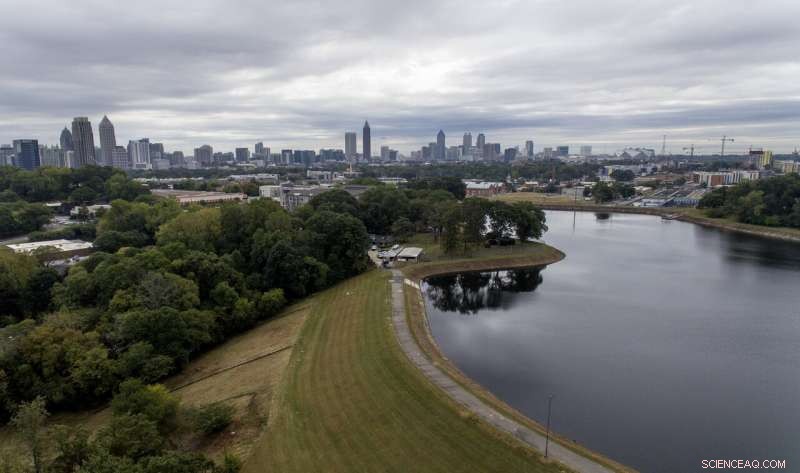
Reservorio No. 1, un suministro de agua de 180 millones de galones que ha estado fuera de servicio gran parte de las últimas décadas, se asienta con el telón de fondo del horizonte de la ciudad, 15 de octubre 2019, en Atlanta. La ciudad hizo reparaciones y volvió a ponerlo en funcionamiento en 2017, solo para apagarlo nuevamente después de que se notaron fugas de agua cerca de los negocios ubicados debajo de la presa. Si la presa fallara catastróficamente, el agua podría inundar más de 1, 000 viviendas unifamiliares, decenas de empresas, un ferrocarril y una parte de la Interestatal 75, según un plan de acción de emergencia. (Foto AP / David Goldman)
En una fría mañana de marzo pasado, Kenny Angel recibió un golpe frenético en su puerta. Dos trabajadores de una empresa de servicios públicos en el norte de Nebraska habían llegado con una severa advertencia:sal de tu casa.
Un poco más de un cuarto de milla río arriba Spencer Dam, de 92 años, se esforzaba por contener la hinchazón, Río Niobrara cubierto de hielo después de una tormenta de nieve y lluvia inusualmente intensa. Los trabajadores habían intentado, pero no pudieron forzar la apertura de las puertas del aliviadero de madera congelada de la presa. Entonces, temiendo lo peor, huyeron en su camioneta, deteniéndose para advertir a Ángel antes de alejarse sin él.
Minutos más tarde, la presa se derrumbó, desatando una ola de agua que transporta trozos de hielo del tamaño de un automóvil. La casa de Angel fue arrasada; Su cuerpo nunca fue encontrado.
"Recibió un aviso de unos 5 minutos, sin previo aviso el día anterior, "Scott Angel, uno de los hermanos de Kenny, dijo.
Los inspectores estatales le habían dado a la presa una calificación de "justa" menos de un año antes. Hasta que falló se veía poco diferente a miles de otros en los EE. UU., y eso podría presagiar un problema.
Una investigación de más de dos años realizada por The Associated Press ha encontrado decenas de represas en todo el país en condiciones aún peores. y en lugares igualmente peligrosos. Se ciernen sobre las casas negocios carreteras o comunidades enteras que podrían enfrentar inundaciones potencialmente mortales si las presas no se mantienen.
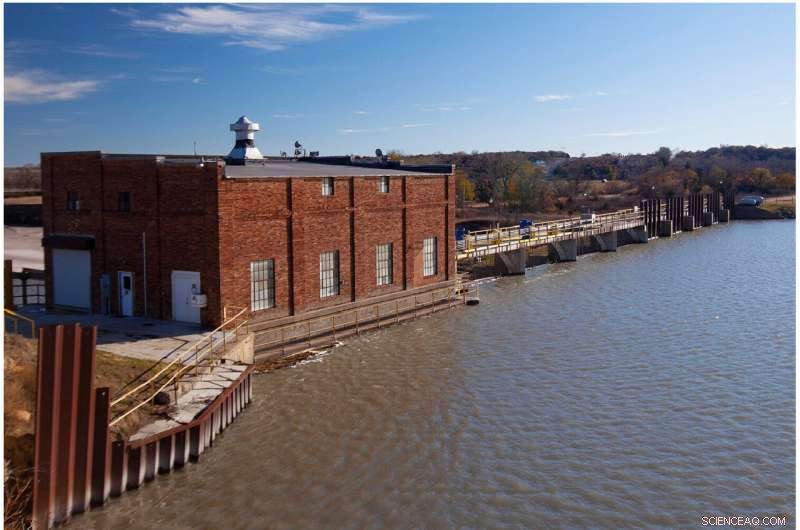
Esta combinación de fotos proporcionada por el Departamento de Recursos Naturales de Nebraska, muestra la presa Spencer cerca de Spencer, Nebraska., en noviembre de 2013, cima, cuando retenía agua en el río Niobrara y nuevamente en marzo de 2019, después de que la presa fallara durante una inundación. Los inspectores estatales le habían dado a la presa una calificación de "justa" menos de un año antes. Hasta que falló se veía poco diferente a miles de otros en los EE. UU., y eso podría presagiar un problema. (Departamento de Recursos Naturales de Nebraska a través de AP)
Una revisión de los datos e informes federales obtenidos según las leyes estatales de registros abiertos identificados 1, 688 represas de alto riesgo calificadas en malas condiciones o insatisfactorias hasta el año pasado en 44 estados y Puerto Rico. El número real es casi con certeza más alto:algunos estados se negaron a proporcionar calificaciones de condición para sus presas, reclamando exenciones a las solicitudes de registros públicos. Otros simplemente no han calificado todas sus represas debido a la falta de fondos. personal o autoridad para hacerlo.
Las muertes por fallas de presas han disminuido desde que una serie de derrumbes catastróficos en la década de 1970 llevaron a los gobiernos federal y estatal a intensificar sus esfuerzos de seguridad. Sin embargo, alrededor de 1, 000 represas han fallado en las últimas cuatro décadas, matando a 34 personas, de acuerdo con el Programa Nacional de Desempeño de Represas de la Universidad de Stanford.
Construido para el control de inundaciones, riego, suministro de agua, energía hidroeléctrica, almacenamiento de residuos industriales o recreativos, Las represas del país tienen en promedio más de medio siglo. Algunos ya no son adecuados para manejar las intensas lluvias e inundaciones de un clima cambiante. Sin embargo, se confía en ellos para proteger a más y más personas a medida que surgen desarrollos de viviendas en las cercanías.
"Hay miles de personas en este país que viven aguas abajo de las represas que probablemente se consideren deficientes dados los estándares de seguridad actuales, "dijo Mark Ogden, un ex funcionario de seguridad de la presa de Ohio que ahora es un especialista técnico de la Asociación de Funcionarios de Seguridad de Presas del Estado.
La asociación estima que se necesitarían más de $ 70 mil millones para reparar y modernizar los más de 90, 000 presas. Pero a diferencia de muchas otras infraestructuras, la mayoría de las represas estadounidenses son de propiedad privada. Eso dificulta que los reguladores exijan mejoras a los operadores que no pueden o no quieren pagar los elevados costos.
"La mayoría de las personas no tienen ni idea de las vulnerabilidades cuando viven aguas abajo de estas represas privadas, "dijo Craig Fugate, ex administrador de la Agencia Federal para el Manejo de Emergencias. "Cuando fallan, no fallan con una advertencia. Simplemente fallan y de repente puedes encontrarte en una situación en la que tienes una pared de agua y escombros corriendo hacia tu casa en muy poco tiempo, Si alguna, salir."
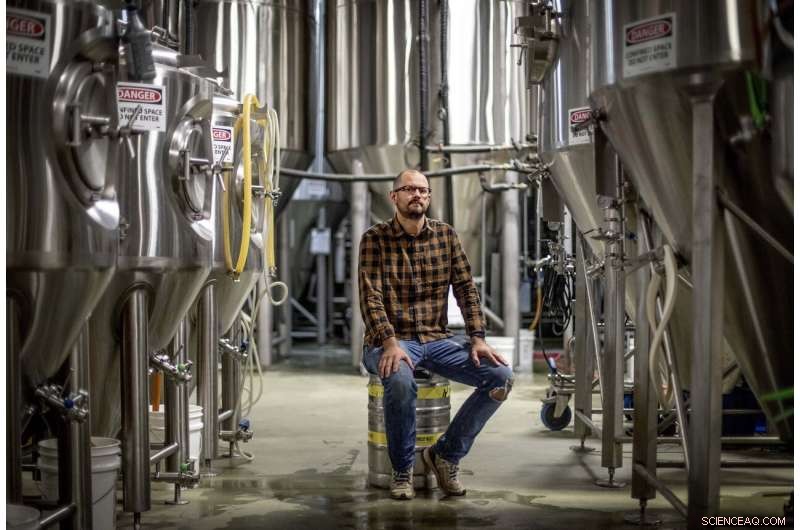
Joel Iverson, director de operaciones de Monday Night Brewing, es fotografiado en la cervecería que se encuentra junto al depósito n. ° 1, un suministro de agua de 180 millones de galones que ha estado fuera de servicio gran parte de las últimas décadas, 15 de octubre 2019, en Atlanta. Iverson había notado anteriormente que el agua goteaba por la ladera de la presa cerca de la cervecería que cofundó. "Si ese va, nos va a lavar y mucha cerveza, "dijo Iverson. (Foto AP / David Goldman)
___
No está claro si Angel, un veterano de la guerra de Vietnam de 71 años, se negó a huir o simplemente se quedó sin tiempo después de que los trabajadores del Distrito de Energía Pública de Nebraska le advirtieran que el agua estaba rebasando la presa cerca de Spencer, una ciudad de menos de 500 habitantes.
Abogado de la esposa de Angel, que no estaba en casa cuando se rompió la presa, ha presentado una demanda de $ 5 millones alegando negligencia. Afirma que la empresa de energía no pudo mantener adecuadamente la presa, capacitar a sus empleados o informar a los Ángeles de las condiciones peligrosas.
A pesar de que la casa de los Ángeles estaba en su camino, la presa fue calificada como un peligro "significativo" en lugar de "alto", lo que significa que la ley de Nebraska no requería tener un plan de acción de emergencia formal. Aproximadamente el 20% de las represas de alto riesgo reguladas por el estado en todo el país aún carecen de planes de emergencia, según el Cuerpo de Ingenieros del Ejército de EE. UU., que mantiene el inventario nacional de represas.
Cuando se inspeccionó por última vez en abril de 2018, La calificación de "aceptable" de Spencer Dam fue acompañada por una notación ominosa:"Existen deficiencias que podrían conducir a fallas en la presa durante los raros, eventos de tormentas extremas ".
Tim Gokie, ingeniero jefe del programa de seguridad de presas de Nebraska, dijo que la advertencia se debió a una filtración de agua pasada que la empresa de energía abordó mediante la instalación de un sistema de drenaje. Por último, Gokie dijo, el creciente río Niobrara simplemente aplastó la presa de concreto y tierra, que fue construido en 1927 para generar hidroelectricidad, no para el control de inundaciones.
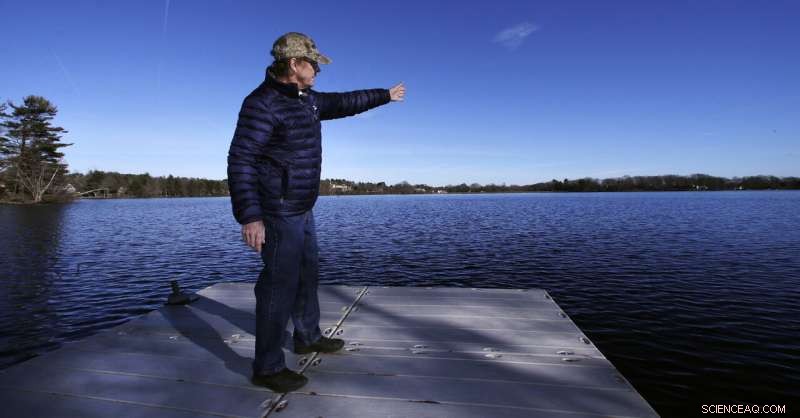
En este 27 de diciembre, 2018, Foto, Playa de Murray, un banquero de inversiones que vive en la orilla de Willett Pond, señala el aliviadero del lago, que se encuentra en la frontera de Norwood y Walpole, Mass. El aliviadero de la presa Willett Pond, de 107 años de antigüedad, es capaz de manejar solo el 13% del flujo de agua de una inundación grave antes de que se sobrepase la presa. según un informe de inspección estatal reciente. "No estamos hablando de simplemente inundar la casa de alguien. Estamos hablando de cubrir su casa, "dijo Beach, que pertenece a un grupo de ciudadanos que ha cabildeado durante años para que se repare el aliviadero. (Foto AP / Charles Krupa)
"El hecho es que se trataba de una situación sin precedentes, "El portavoz del Distrito de Energía Pública de Nebraska, Mark Becker, dijo." Fue más allá de lo que todos anticiparon ".
Nebraska fue uno de los estados más afectados por tormentas e inundaciones este año que han causado daños a las carreteras por un valor estimado de $ 1.5 mil millones. presas, servicios públicos y otra infraestructura en 28 estados, según un análisis AP.
Una Evaluación Nacional del Clima publicada por la Casa Blanca el año pasado señaló la creciente frecuencia e intensidad de las tormentas a medida que cambia el clima. Eso puede empujar algunas presas más allá de lo que fueron diseñadas para manejar.
Incluso si se mantiene en buenas condiciones, miles de represas podrían estar en riesgo debido a tormentas extremas, dijo Fugate, el ex funcionario de FEMA.
"These are like ticking bombs just sitting there, waiting for the wrong conditions to occur to cause catastrophic failure, " él dijo.
___
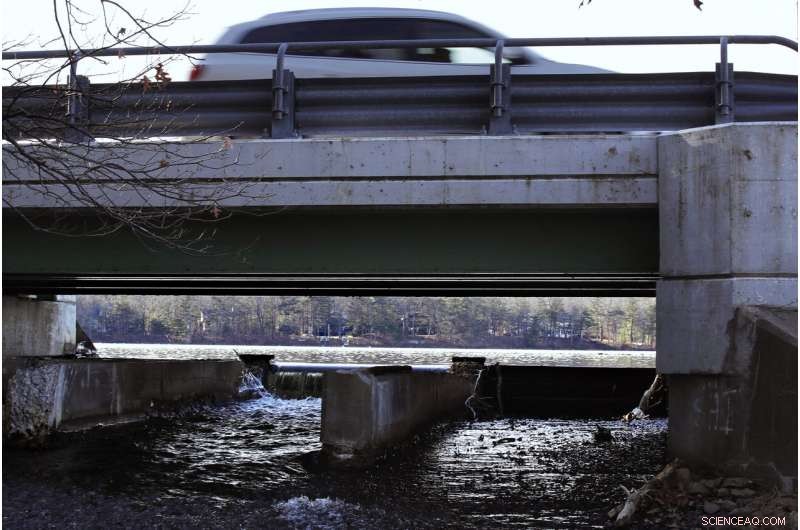
A vehicle passes over the spillway at Willett Pond on the border of Norwood and Walpole, Mass., Dec. 27, 2018. If the dam were to give way, it could send hundreds of millions of gallons of water into the heart of the Norwood, a Boston suburb of nearly 30, 000 personas. (AP Photo/Charles Krupa)
The nation's dams are categorized as high, significant or low hazard in the National Inventory of Dams database. High hazard means loss of human life is likely if a dam were to fail. A significant rating means no deaths are likely, although economic and environmental damage are possible.
There is no national standard for inspecting dams, leading to a patchwork of state regulations. Some states inspect high-hazard dams every year while others wait up to five years. Some states never inspect low-hazard dams—though even farm ponds can eventually pose a high hazard as housing developments encroach.
Dam conditions are supposed to be rated as unsatisfactory, poor, fair or satisfactory. But the ratings are subjective—varying by state and the interpretations of individual inspectors—and are not always publicly disclosed.
Since the Sept. 11, 2001, terror attacks, the U.S. government has cited national security grounds in refusing to include dams' conditions in its inventory, which was updated most recently in 2018. But the AP was able to determine both condition and hazard ratings for more than 25, 000 dams across the country through public records requests.
The tally includes some of the nation's most well-known dams, such as Hoover Dam along the Colorado River, but mostly involves privately owned dams. Many are used for recreation.
The AP then examined inspection reports for hundreds of high-hazard dams in poor or unsatisfactory condition. Those reports cited a variety of problems:leaks that can indicate a dam is failing internally; unrepaired erosion from past instances of overtopping; holes from burrowing animals; tree growth that can destabilize earthen dams; and spillways too small to handle a large flood. Some dams were so overgrown with vegetation that they couldn't be fully inspected.
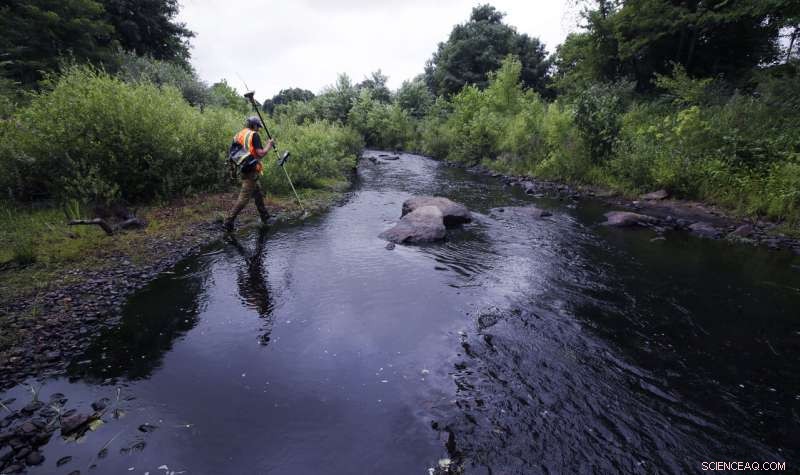
A surveyor walks the banks of the Mill River, at the site of the former Whittenton Pond Dam, just upstream from downtown Taunton, Mass., July 25, 2018. The dam was removed following concerns that the 170-year-old plus structure could fail, after it buckled and nearly failed in 2005. (AP Photo/Charles Krupa)
Georgia led the nation with nearly 200 high-hazard dams in unsatisfactory or poor condition, according to the AP's analysis.
Among them is Reservoir No. 1 in Atlanta, a 180 million-gallon water supply dating to the late 1800s that has been out of service much of the past few decades. The city made repairs and brought it back online in 2017, only to shut it down again after leaks were noticed.
If the dam were to catastrophically fail, the water could inundate more than 1, 000 homes, dozens of businesses, a railroad and a portion of Interstate 75, according to an emergency action plan .
Joel Iverson has previously noticed water trickling out of the dam near the brewery he co-founded, Monday Night Brewing.
"If that one goes, it's going to wash away us and a lot of beer, " Iverson said.
The Atlanta Watershed Management Department declined the AP's request for an interview about the reservoir and instead asked for questions in writing. When those were submitted, it declined to answer them.
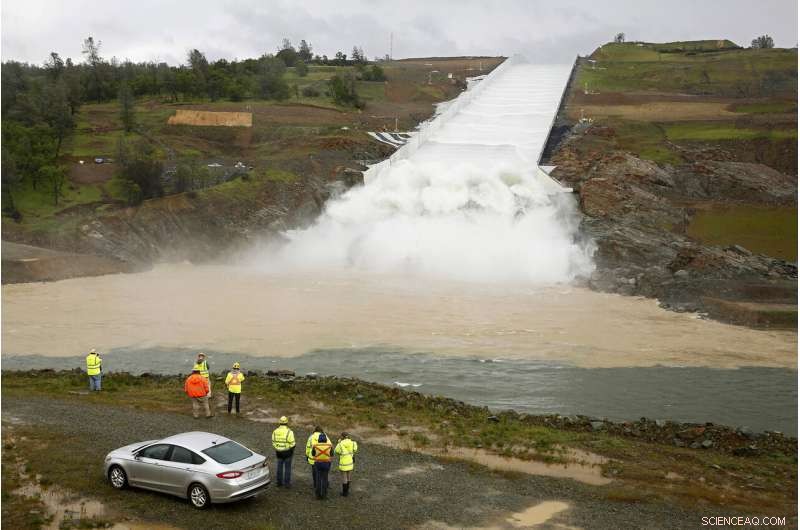
In this April 2, 2019, foto de archivo, water flows down the Oroville Dam spillway in Oroville, Calif. The state spent $1.1 billion repairing the Lake Oroville spillway, enacted new emergency plan requirements and launched a review of 93 other dams with similar spillways. (Foto AP / Rich Pedroncelli, Expediente)
___
One of the most common problems for aging dams are spillways incapable of handling an extreme rainfall event.
If water can't escape quickly enough through spillways, it could flow over the top of a dam, which increases the probability of rapid erosion that can cause it to collapse.
The spillway at the 107-year-old Willett Pond Dam near the Boston suburb of Norwood is capable of handling just 13% of the water flow from a serious flood before the dam is overtopped, according to a recent state inspection report. If the dam were to give way, it could send hundreds of millions of gallons of water into the heart of the city of nearly 30, 000 personas.
"We are not talking of just flooding someone's house. We are talking about covering their house, " said Murray Beach, who lives on the shore of the 220-acre privately owned lake and belongs to a citizens group that has lobbied for years for the spillway to be repaired.
A 2017 inspection report said improvements to the spillway could cost between $1 million and $5 million. A nonprofit that owns the lake received a $215, 000 state grant last year to design spillway improvements. But there is no timeline to fix it.
In this Nov. 30, 2017, foto de archivo, work continues on the Oroville Dam spillway in Oroville, Calif. The scare at Oroville, the nation's tallest dam, led to evacuation orders for nearly 200, 000 people, although no one was injured and the dam ultimately held. (Foto AP / Rich Pedroncelli, Expediente) 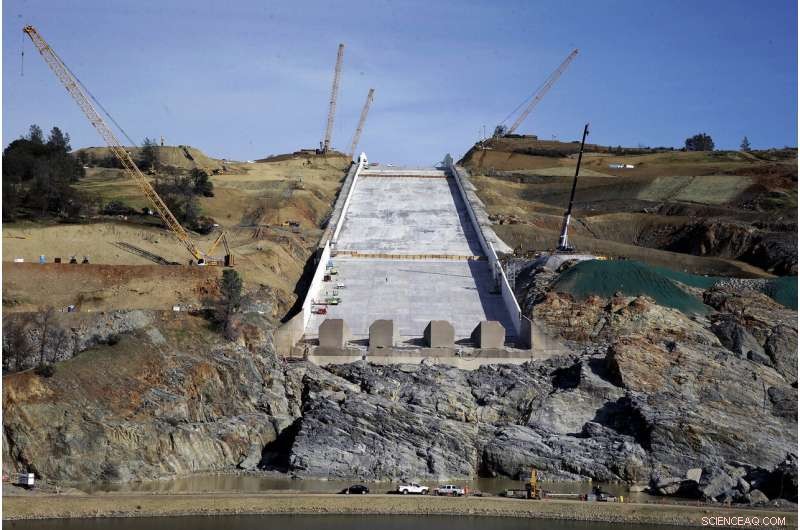
Tamiko Porter, who operates a Montessori school serving some 75 students, said she was surprised to learn there was a dam upstream that could flood her school if it failed.
"Oh God, please let it happen when my kids aren't here, " Porter said.
Norwood emergency management director Bernard Cooper said there is no imminent risk of dam failure.
"Sí, it needs work. The spillway should be rebuilt. Absolutely, no question, " Cooper acknowledged. But "there is no money in the system for that."
Concerns about inadequate dam spillways date back decades to when the Corps of Engineers undertook its first nationwide assessment of dams posing a high risk to life and property. From 1978 to 1981, the Corps inspected 8, 818 dams. About one-third were deemed unsafe due to deficiencies, and about 80% of those cited inadequate spillway capacities.
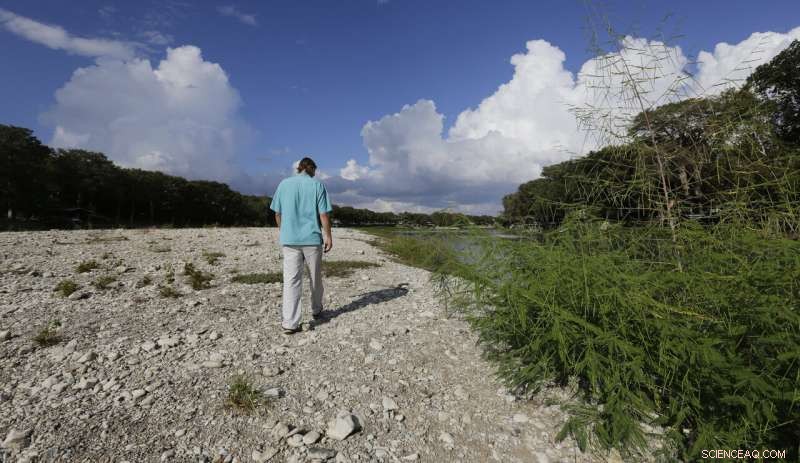
Hunter Croan walks along a dried-up section of Lake Dunlap, 30 de septiembre 2019, in Lake Dunlap, Texas. Croan is one of many homeowners who were left high and dry, their lakeside docks now dry as the Guadalupe River retreated to its natural bed after the the center spill gate of the lake's 91-year-old dam failed. (AP Photo/Eric Gay)
One of the dams cited for a "seriously inadequate" spillway in 1978 was Lake Sebago, located in a New York state park near the village of Sloatsburg. Forty years later, nada ha cambiado.
A 2018 state inspection letter warned of "inadequate spillway capacity and dam stability" and asked for an improvement plan within 30 days. None was provided.
The state dam safety office has no authority to force the state parks department to make repairs.
To modify the Lake Sebago spillway, workers would have to rebuild a road and bridge that pass over the dam. The project could cost over $15 million, said Jim Hall, the recently retired executive director of the Palisades Interstate Park Commission, which manages multiple dams.
"That structure has been in place with the same spillway capacity for over probably 60 to 70 years and it hasn't been overtopped, " Hall said. "Should it be improved to meet all codes? Sí, eso estaría bien. Does it make it the highest priority for us to do in relation to other dam structures we have? Probably not."
___
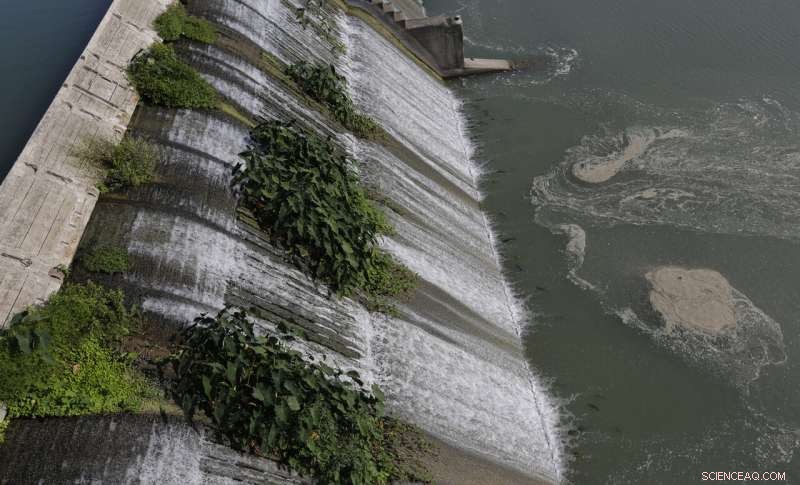
Water flows over a spill gate on Lake McQueeney, 2 de octubre 2019, Lake McQueeney, Texas. A judge has issued a 12-month temporary injunction preventing the draining of McQueeney and five other lakes along the Guadalupe River after property owners sued. (AP Photo/Eric Gay)
In a 1982 report summarizing its nationwide dam assessment, the Corps of Engineers said most dam owners were unwilling to modify, repair or maintain the structures, and most states were unwilling to spend enough money for an effective dam safety program.
Since then, every state but Alabama has created a dam safety program.
But the Great Recession a decade ago forced many states to make widespread budget and personnel cuts. Since a low point in 2011, states' total spending on dam safety has grown by about one-third to nearly $59 million in the 2019 fiscal year while staffing levels have risen by about one-fifth, according to data collected by the Corps of Engineers.
California, which runs the nation's largest dam safety program, accounts for much of that gain. It boosted its budget from $13 million to $20 million and the number of full-time staff from 63 to 77 following the failure of the Oroville dam spillway in 2017.
The scare at Oroville, the nation's tallest dam, led to evacuation orders for nearly 200, 000 people, although no one was injured and the dam ultimately held. An independent investigation cited "a long-term systemic failure " by regulators and the dam industry to recognize and address warning signs.
California spent $1.1 billion repairing the Lake Oroville spillway, enacted new emergency plan requirements and launched a review of 93 other dams with similar spillways.
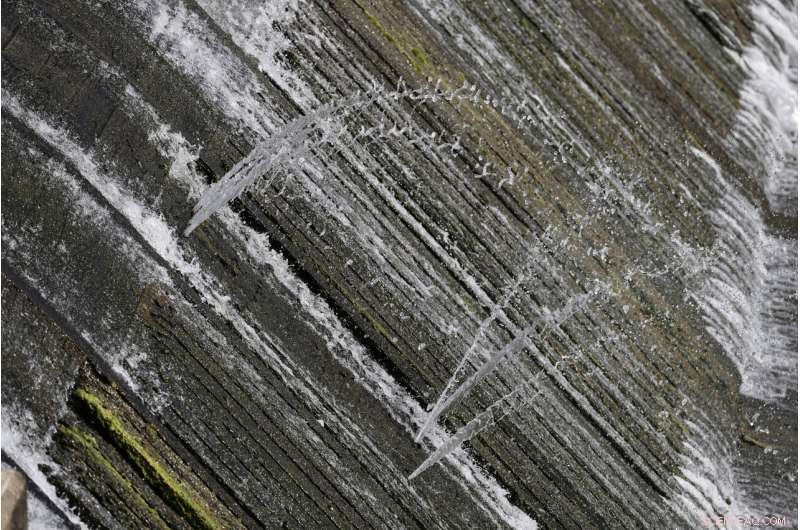
Water spurts through a wood section of a spill gate on Lake McQueeney, 2 de octubre 2019, Lake McQueeney, Texas. A judge has issued a temporary injunction preventing the draining of the lakes along the Guadalupe River as a result of an agreement between suing property owners and the Guadalupe-Blanco River Authority. (AP Photo/Eric Gay)
In South Carolina, after more than 70 dams failed following heavy rains in 2015 and 2016, the state tripled the personnel in its dam safety program and ratcheted up spending from about $260, 000 annually to more than $1 million.
But some states have continued to pare back their dam safety programs. Thirteen states and Puerto Rico were spending less in 2019 than they did in 2011, and 11 states had fewer full-time positions in their programs.
The Association of State Dam Safety Officials says almost every state faces a serious need to pump additional money and manpower into dam safety programs.
"If you don't have the staff to inspect a dam, or don't have the authority to do that, you don't know what the problems are, " said the association's Ogden.
"If you are able to do the inspection but you can't follow up, and you have dam owners who don't have the resources to fix their dam, then ultimately you know what the problem is but you can't get it addressed, "añadió.
Many states face a quandary when it comes to problematic private dams when they can't identify the owners. Rhode Island's two-person dam safety office last year listed 32 high- or significant-hazard dams with safety concerns whose owners were unknown.
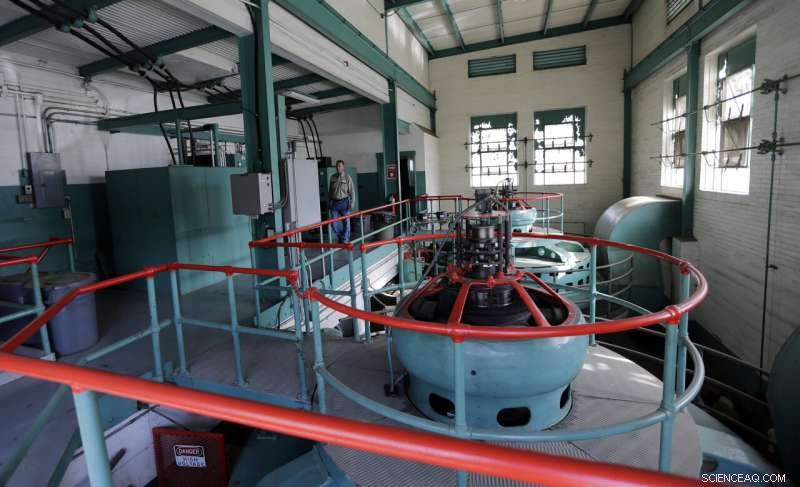
Guadalupe-Blanco River Authority's John Moryl walks through the hydroelectric plant at the spill gates on Lake McQueeney, 2 de octubre 2019, in Lake McQueeney, Texas. The Guadalupe-Blanco River Authority announced plans to drain a chain of six lakes, including Lake McQueeney. (AP Photo/Eric Gay)
"If we don't know the owner, then we can't take any action to order anybody to fix it, " said David Chopy, chief of compliance and inspection for the Rhode Island Department of Environmental Management.
In some states, dams go uninspected because of exemptions in state law.
A 2013 Texas law exempts all dams on private property with a capacity of less than 163 million gallons that are rated significant or low hazard and are located outside of city limits in any county with fewer than 350, 000 personas. Como resultado, about 45% of its roughly 7, 200 dams are exempt from regulation.
Missouri performs safety inspections on only about 650 of its more than 5, 000 dams. That's because state law exempts all dams that are under 35 feet, used for agricultural purposes or subject to federal regulation.
Former Missouri Gov. Matt Blunt attempted to significantly expand the number of dams under state supervision after the mountaintop Taum Sauk Reservoir collapsed in December 2005, injuring a state park superintendent's family. But the legislation failed after some rural landowners expressed concerns. Then the proposal quietly faded away as new officials took over.
"Maybe it's time to take a look at that again and make sure that our dams are safe, " said Missouri state Rep. Tim Remole, who now leads the House committee overseeing dam safety.
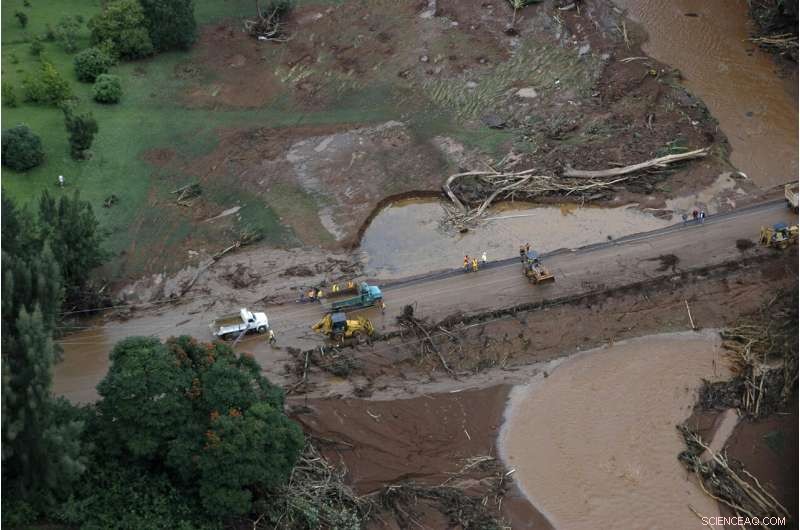
This March 14, 2006, foto de archivo, shows damage after a dam burst near Kilauea, on the Hawaiian island of Kauai. An earthen wall of the Kaloko Reservoir collapsed during heavy rains and sent a wave of water and mud rushing down a hillside. Seven people were killed on Bruce Fehring's property, including his daughter, son-in-law and grandson. (AP Photo/Casey Riemer, Expediente)
___
Until Angel's death in Nebraska this year, the last fatal dam failure in the U.S. occurred on the Hawaiian island of Kauai in 2006.
An earthen wall of the Kaloko Reservoir collapsed during heavy rains and sent a wave of water rushing down a hillside. Seven people—including a pregnant woman—were killed on Bruce Fehring's property, including his daughter, son-in-law and grandson.
Fehring, who wasn't there at the time, got a phone call from a neighbor saying something terrible had happened. He was shocked by the scene.
"It took a while to register, and I went, 'Oh my God, everything's been washed away, '" Fehring recalled. "I mean, you have no idea the power of water (until) you see what it can do in a very short amount of time."
Dam owner James Pflueger pleaded no contest to felony reckless endangerment and was sentenced to seven months of confinement and five years of probation. His property company pleaded no contest to seven counts of manslaughter. Prosecutors said Pflueger had filled in the dam's spillway while attempting to make space for a waterfront development.
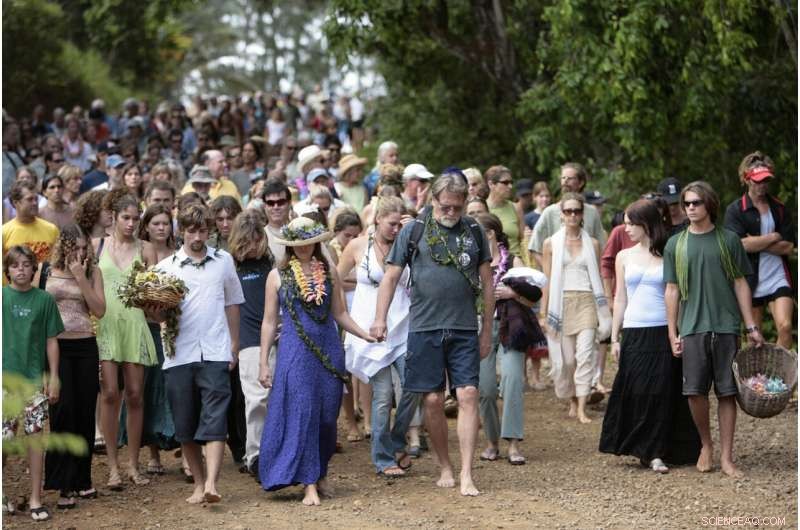
In this May 21, 2006, foto de archivo, Bruce Fehring and his wife Cyndee, centrar, lead a procession toward Kahili Quarry Beach during a memorial service to honor those killed when the Kaloko Dam failed in Kilauea, on the Hawaiian island of Kauai. An earthen wall of the Kaloko Reservoir collapsed during heavy rains and sent a wave of water and mud rushing down a hillside. Seven people were killed on Fehring's property, including his daughter, son-in-law and grandson. (Jamm Aquino/Honolulu Star-Bulletin via AP, Expediente)
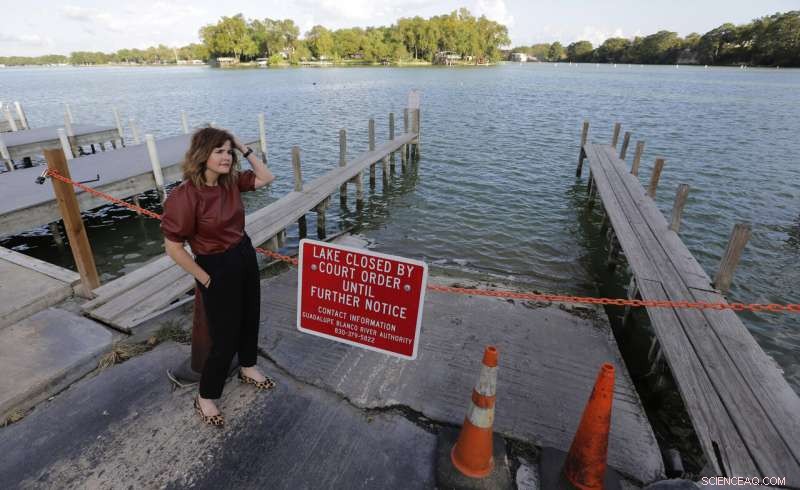
Tess Coody-Anders, a university executive and homeowner near Lake McQueeney, one of the dams slated to be drained, stands near a sign showing the lake is closed, 30 de septiembre 2019, in Lake McQueeney, Texas. "This is something that communities and states all across the country are grappling with as we are reckoning with our aging infrastructure, " said Coody-Anders. (AP Photo/Eric Gay)
The victims' families and those whose property was damaged, including actress Bette Midler, agreed to a $25 million civil settlement. Though categorized by the state as low hazard at the time it failed, Kaloko Reservoir is now listed as a high-hazard facility in poor condition . It remains largely unrepaired.
That's also the case with Lake Dunlap Dam, northeast of San Antonio. On a sunny morning in May, one of the 91-year-old dam's corroded spillway gates suddenly gave way. No one was hurt in the rush of water, but scores of homeowners' lakeside docks were left high and dry, facing barren swaths of dried lakebed after the river retreated, leaving boats stranded.
The dam was the second hydroelectric facility along the river to fail within the past three years. The Guadalupe-Blanco River Authority responded with plans to drain a chain of four lakes because of concerns their similarly designed spillway gates also could fail.
But after property owners sued, the river authority agreed in September to a temporary injunction delaying the plan for a year. That could allow time to find funding for the estimated $90 million to $210 million to repair the dams.
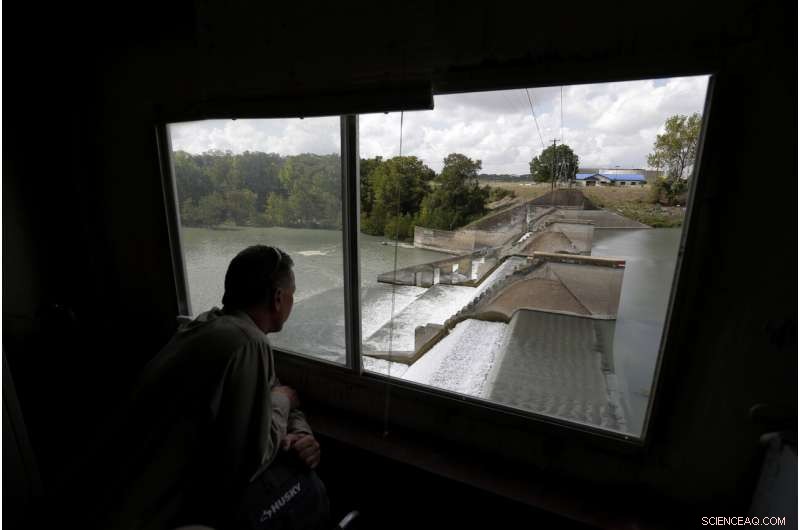
Guadalupe-Blanco River Authority's John Moryl looks over the spill gates at Lake Dunlap, 2 de octubre 2019, in Lake Dunlap, Texas. One of the spill gates at the dam failed in May and the lake drained down to the original channel of the Guadalupe River. (AP Photo/Eric Gay)
"This is something that communities and states all across the country are grappling with as we are reckoning with our aging infrastructure, " said Tess Coody-Anders, a homeowner near Lake McQueeney, one of the dams slated to be drained.
"I hope that everyone will recognize that, like in our community, entire economies and ways of life have developed around what started out as a civil engineering project, " she added. "And you can't take that away."
© 2019 The Associated Press. Reservados todos los derechos.